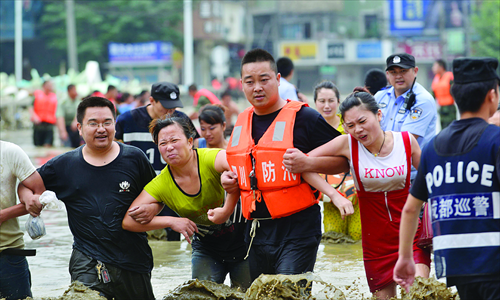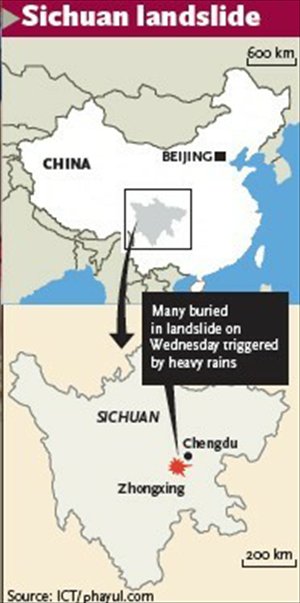Storms across nation cause landslides, collapse bridges

Police officers evacuate residents to safer areas in Jintang county, Chengdu, Southwest China's Sichuan Province on Wednesday. Photo: CFP

Strong rainstorms have swept regions all over China, causing a range of disasters including a landslide that killed two people and left 21 unaccounted for, as well as a bridge collapse that resulted in a dozen missing people, both in Southwest China's Sichuan Province.
The storm-triggered landslide took place on Wednesday morning in Sanxi village, Zhongxing township, Dujiangyan, flattening 11 houses and killing two people.
Rescuers from Chengdu, which is 48 kilometers away, have arrived at the scene for rescue and relief efforts.
A firefighter, who was dispatched to the area, told China Central Television Wednesday that the continuing rain and large areas of mud, rocks and debris have made the rescue more difficult.
He also said that some 300 local residents were transferred to safer areas by rescue crews.
Meanwhile, Xinhua reported that more than 2,000 people who had been trapped in a highway tunnel linking Dujiangyan and Wenchuan county were rescued and relocated, local authorities said on Wednesday evening. The tunnel was closed by the landslide.
Dujiangyan was one of the worst-hit regions in the devastating Wenchuan earthquake in 2008.
Guo Huadong, director of the Center for Earth Observation and Digital Earth at the Chinese Academy of Sciences, told the Global Times Wednesday that it is likely that the landslide is related to the quake and geological instability in the area.
In Jiangyou, Sichuan, the number of people reported missing after a bridge collapse amid severe flooding rose to 12 on Wednesday, and six vehicles plunged into the river.
Yang Yanming, an official from the Jiangyou government, told the Global Times Wednesday that the number of victims might rise as the rescue continues.
The Panjiang Bridge was only put into use several days ago, after undergoing reinforcement following the 2008 quake, which has focused public scrutiny on the roles of local authorities in its construction.
"The storm led to a sudden increase in the Panjiang River flows, making it a 6,600 cubic meters per second flood, which has never been recorded in the last 50 years. Besides, the flood carried too much mud which made it destructive to bridges," Yang said.
In order to avoid more bridges collapsing, Yang said the local government organized experts to examine the safety and conditions of all the local bridges.
However, an opinion piece on news portal eastday.com accused local authorities of "risking the public's safety" by putting the bridge into use, and noted that the rainstorms and the high volume of mud contained in floodwater were only the "last straw" for the bridge collapse.
There were at least another two bridge collapses in Sichuan due to floods, Xinhua reported.
Elsewhere in the country, another 20 provincial-level regions and around 6 million people have been affected by rainstorms, Xinhua reported.
A storm in Shouyang, Shanxi Province, led to the collapse of a makeshift house which killed 12, while in Suijiang, Yunnan Province, a storm-triggered torrent killed four, affecting the lives of some 7,000 local residents.
The National Meteorological Center (NMC) issued a blue storm warning, the lowest alert level, on Wednesday.
An NMC official, who didn't reveal his name, told the Global Times that as many as six Chinese provinces will have storms on Thursday, calling on local authorities to take measures to avoid disasters.
"Compared with previous years, the Chinese flood season is longer and stronger this year. Even in places like Hebei and Shaanxi provinces, which are supposed to be dry, there are heavy rainstorms. This abnormal climate change suggests that China is being affected by global warming," Mu Jianxin, a research fellow with the Department of Irrigation and Drainage at the China Institute of Water Resources and Hydropower Research, told the Global Times Wednesday.
According to Mu, the average temperature of China has risen more than two degrees since the 1950s.